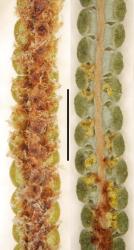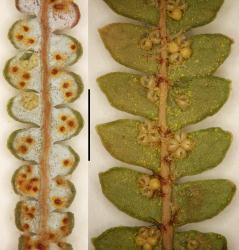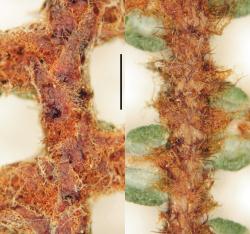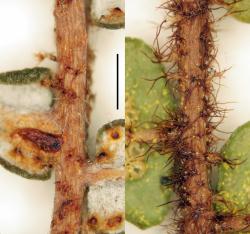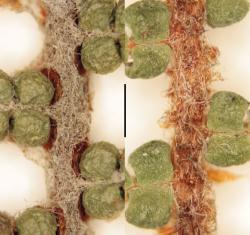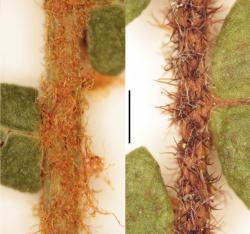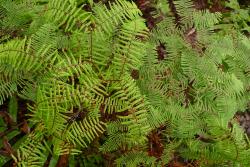- = Calymella C.Presl, Tent. Pterid. 48, t. 1(3) (1836)
- = Gleicheniastrum C.Presl, Gefässbündel Farrn 30 (1847)
Terrestrial ferns. Rhizomes long-creeping, scaly. Stipes scaly or glabrescent. Rachis with pinnate lamina (not NZ), or absent with a single pair of pinnae (not NZ), or reduced to a bud at the apex of the stipe with a single pair of pinnae (NZ); rachis buds sometimes extending to produce another tier comprising a rachis terminating in another rachis bud and pair of pinnae. Pinnae unforked, comprising a β costa with ultimate leaflets (occasionally NZ), or forking pseudodichotomously 1 to several times (NZ); buds at bifurcations sometimes extending 1-several times. Laminae, axes, and rachis and pinna buds bearing scales, sometimes hair-like. β costae bearing ultimate leaflets. α costae of the ultimate leaflets arranged pinnately on β costae. Ultimate segments on α costa <3 mm long, ± square or ovate, entire, with simple (and obscured) veins between midvein and margin. Sori superficial or embedded in lamina, one on each ultimate segment, each with 2–5 sporangia. Spores trilete, radially symmetrical, plain or shallowly rugulate.
A genus of at least 12 species.
Allan (1961) included species now attributed to Dicranopteris and Sticherus in a broadly-circumscribed Gleichenia. Recent treatments generally accept Dicranopteris and Sticherus as separate genera and a narrowly-circumscribed Gleichenia (Smith et al. 2006; Christenhusz et al. 2011). The nomenclatural history of Gleichenia was detailed by Pichi Sermolli (1972).
| 1 | Sori embedded to more than half their height in conspicuous pits within abaxial surface of laminae; scales on abaxial surface of laminae ± orbicular | inclusisora |
| Sori ±superficial on abaxial surface of laminae; scales on abaxial side of laminae ovate or stellate (with hair-like branches) but not orbicular | 2 | |
| 2 | Scales on abaxial surface of α costae not percurrent (i.e., not extending to its apex); abaxial surface of ultimate segments glabrous | 3 |
| Scales on abaxial surface of α costae percurrent (i.e., extending to its apex); abaxial surface of ultimate segments usually with minute, branched, hair-like scales | 4 | |
| 3 | Ultimate segments green on abaxial surface, complanate or recurved but not pouched, with at least some apices cuspidate (± triangular); most sori with >2 sporangia; indumentum of abaxial surface of β costae dominated by stellate scales with stiffly patent branches, along with some ovate scales | microphylla |
| Ultimate segments white or glaucous on abaxial surface, recurved or pouched, with rounded apices; most or all sori with 2 sporangia; indumentum of abaxial surface of β costae comprising an intergrading mix of ovate scales and stellate scales with patent or curled branches | dicarpa | |
| Not with either of the above combinations of character states (e.g., ultimate segments with glaucous abaxial surfaces and ± complanate; ultimate segments pouched and indumentum of abaxial surface of β costae dominated by stellate scales with stiffly patent branches) | ×punctulata | |
| 4 | β costae lacking stellate scales with patent branches, 11–73 mm long, with 4–14 pairs of ultimate leaflets; adaxial surface of ultimate segments strongly convex; pinna buds usually extending, often more than once; pinnae with 0–1 (rarely 2) pseudodichotomous forks (excluding growth from pinna buds) | alpina |
| β costae bearing stellate scales with patent branches on abaxial and/or adaxial surfaces (branches curled in Chatham Islands’ plants), 29–230 mm long, with 7–50 pairs of ultimate leaflets; adaxial surface of ultimate segments complanate or weakly convex; pinna buds occasionally extending but rarely more than once; pinnae with 1–4 (rarely 0 or 5) pseudodichotomous forks (excluding growth from pinna buds) | dicarpa |
In New Zealand, the ultimate segments less than 3 mm in length distinguish Gleichenia from Dicranopteris and Sticherus which have ultimate segments at least 5 mm long.
At least 12 species distributed in the Old World tropics and temperate regions, extending from southern Africa, through south-east Asia to Australia, New Zealand and New Caledonia (Perrie et al. 2012); three species in Africa and islands of the western Indian Ocean, four in south-east Asia, six in Australia, one in Solomon Islands, and one in New Caledonia. Four species in New Zealand; one endemic.
| Category | Number |
|---|---|
| Indigenous (Endemic) | 1 |
| Indigenous (Non-endemic) | 4 |
| Total | 5 |
The base chromosome number in Gleichenia is x = 20 or 22 (Kramer 1990).
In relation to the measurements reported here for the trilete spores of Gleichenia, "length" is the longest of the three distances between the (three visible) corners and the midpoint of their respective opposite face, and "width" is the length of that face.
Morphological intermediates occur amongst New Zealand’s Gleichenia, combining character states that would otherwise characterise different species and/or exhibiting intermediate character states. Such plants do not appear to have the abnormally-formed spores that characterise many (but not all) fern hybrids. Nevertheless, these morphologically intermediate plants are treated here as putative hybrids, and they are particularly common between G. dicarpa and G. microphylla (see G. ×punctulata).



